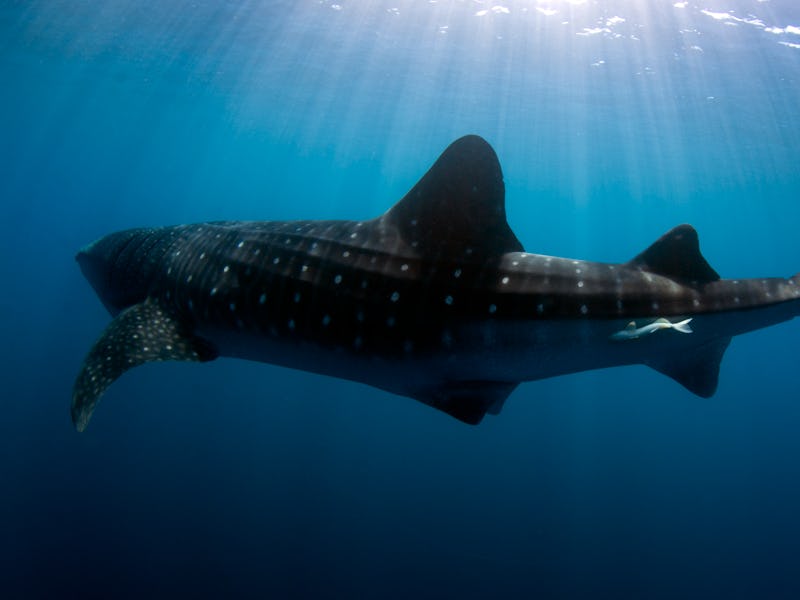Cold War nuclear bomb testing solves an enduring underwater mystery
The age of a gigantic marine animal has puzzled researchers for decades. A new study suggests we may finally have an answer.

Its mouth permanently agape, the world's largest fish swims slowly through the sea. As they glide through the water, they filter it through their massive maws.
These incredible creatures are whale sharks, an endangered species that lives in tropical waters.We know a little about these marine giants: Whale sharks eat plankton and make a yearly migration to Australia.
But there is a crucial detail about these animals that has completely eluded researchers: Their age.
Like other sharks and rays, whale sharks don’t have the bones that help scientists assess the ages of other fish.
But there may be a way to get an accurate age estimate for the whale shark, after all. The answer comes in the form of a bizarre mashup of Cold War history and marine science.
Unexpectedly, the fallout of Cold War nuclear bomb tests have helped researchers nail down the age of whale sharks for the first time.
In a new study, researchers used carbon dating to figure out that whale shark bodies grow a new, internal ring each year — much like a tree, counting these rings determine the age of an individual.
Here's why the bombs hold the key: Testing these bombs has left a specific, high signature of a form of carbon, an isotope called carbon-14. This isotope is more commonly used by archaeologists to date their dig findings. By tracing the carbon-14 levels in the sharks' growth rings, researchers could pinpoint the rings that corresponded with a nuclear test. Knowing when the rings were created reveals how often they form, and thus, the age of the animal.
The findings solve an enduring underwater mystery, settling a debate among researchers about how often these growth rings are deposited.
The new research clears up an old debate about how an icon of our oceans ages.
The findings were published on Monday in the journal Frontiers in Marine Science.
Bombs in the air tell time in the ocean — The United States, Soviet Union, United Kingdom, France, and China all carried out nuclear weapons tests throughout the 1950s and 1960s. Sometimes those explosions happened several kilometers up in the air.
But fallout from the bombs traveled downward. And today, it serves an important role in research.
When radioactive fallout from explosions drifted from the air into the ocean, carbon-14 left its mark in marine life, making its way throughout the food web. Even today, these heightened levels of carbon-14 persist in the ocean.
A whale shark vertebra from Pakistan, in cross section, showing 50 growth bands
This slow decay acts as a timer; researchers compare the amount of carbon-14 decay against the substance’s half-life to determine the age of a sample.
In the new research, the team used carbon-14 levels in successive growth bands of two whale shark specimens, which had been stored in Pakistan and Taiwan. By being able to tell when the bands were created, they could tell the age of the animals — and solve the scientific mystery.
Putting to rest a fishy debate — Scientists studying the whale shark already knew that, like trees or teeth, the fish add more distinct internal bands within its cartilage over time. But researchers were split on how frequently the bands accumulated: Some studies suggested the rings were laid down annually, but other findings put the frequency at every six months.
Now, the debate is over.
"We found that one growth ring was definitely deposited every year," said lead author Mark Meekan, a researcher at the Australian Institute of Marine Science, in a statement.
Filter feeders like whale sharks sift through the ocean to draw out yummy plankton.
Having a better sense of a whale shark’s lifespan could aid conservation efforts for the endangered animal.
"This is very important, because if you over- or under-estimate growth rates you will inevitably end up with a management strategy that doesn't work, and you'll see the population crash,” Meekan said.
The new research confirms earlier research suggesting these fish can live for a long time. One of the specimens tested died at age 50, but now researchers can say definitely that some whale sharks live to be 100 years old.
"Our study shows that adult sharks can indeed attain great age and that long lifespans are probably a feature of the species,” Meekan said.
“Now we have another piece of the jigsaw added."
Abstract: Conservation and management strategies for endangered and threatened species require accurate estimates of demographic parameters such as age and growth. The whale shark, Rhincodon typus, is the largest fish in the world and is highly valued in the eco-tourism sector. Despite conservation concerns and advances in our understanding of their life history, basic demographic parameters for growth, longevity and mortality are of questionable accuracy; previous growth studies could not agree whether the vertebral growth bands were formed annually or biannually. Here, we provide the first validation of the annual formation of growth bands within the vertebrae of the whale shark using bomb radiocarbon assays. Ages of up to 50 years were estimated from sectioned vertebrae of sharks collected in Taiwan and Pakistan. There was no cessation of the formation of growth bands in the vertebrae of older sharks and our study provides the oldest observed longevity for this species. Initial estimates of growth (k = 0.01– 0.12) and natural mortality rates (M = 0.09) are consistent with those expected of long-lived sharks, which highlights their sensitivity to fishing pressure and conservation concerns.